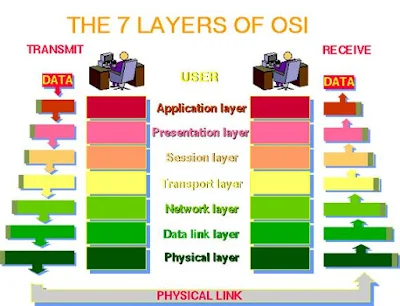OSI Model is an important topic for computer awareness section of banking exams. Today I am going to explain this concept in simple language.
OSI
- OSI stands for Open System Interconnection Model(OSI Model).
- It use to transfer data over a network which moves through different layer.
- It has 7 layer which divided into two level : upper or host & lower or media level
- data moves through different stages like (in ascending order) bits,frames,packets,segments.
Working of OSI
- Physical layer :
- Prepare the physical devices enabling devices for transmission of data and data is received.
- It is responsible for establish and termination of connection between two nodes over a network.
- It defines the medium of transmission of data like: simple(one way transmission,eg t.v),half duplex(two way transmission but partially,eg: walki talki), full duplex(Two way transmission of data, eg: mobile or phone)
2. Data link Layer :
- It provides permission to devices for gain access to data.It controlling devices over a netwrork.
- Data is sent to Network layer in the form of packets and it is responsible to controls error checking and packet synchronization.
- In a network each node(computer) has a unique address here network layer is responsible for letting the data to its destination address or node.
- It splits the data or message into several fragments, delivering each fragment by a separate route and reassembling the fragments, report delivery errors, etc.(like phone calls which you made, first it sounds like beep that is a second which it take to you to connect with available line.)
- It manages connection and handle errors while delivering of data or message over a network.
Feature name | TP0 | TP1 | TP2 | TP3 |
| Connection-oriented network | Yes | Yes | Yes | Yes |
| Connectionless network | No | No | No | Yes |
| Concatenation and separation | No | Yes | Yes | Yes |
| Segmentation and reassembly | Yes | Yes | Yes | Yes |
| Error recovery | No | Yes | Yes | Yes |
| Reinitiate connection (a) | No | Yes | No | No |
| Multiplexing / demultiplexing over single virtual circuit | No | No | Yes | Yes |
| Explicit flow control | No | No | Yes | Yes |
| Retransmission on timeout | No | No | No | Yes |
| Reliable transport service | No | Yes | No | Yes |
| (a) If an excessive number of PDUs are unacknowledged. | ||||
5. Session layer :
- It starts , manages and stop the connection between nodes.
- It provides checkpointing, adjournment, termination, and restart procedures.
- It encrypt the message or data and provide to application layer.
- It interact with software.
- Some example of Application layer : Web Browser , Mails





